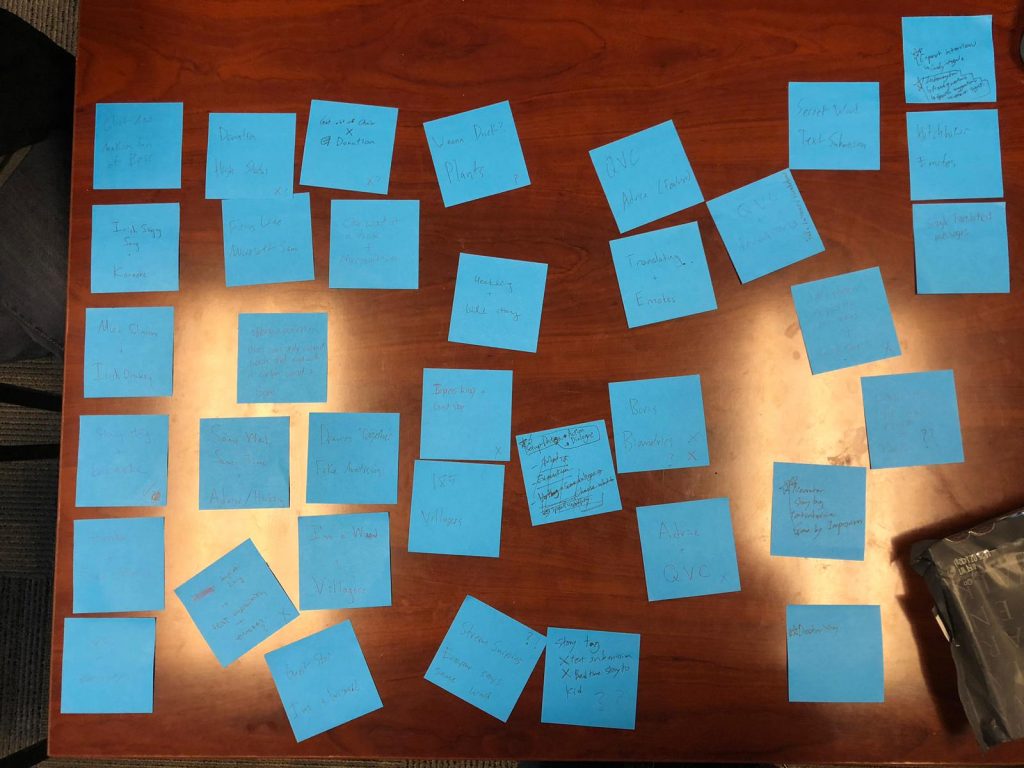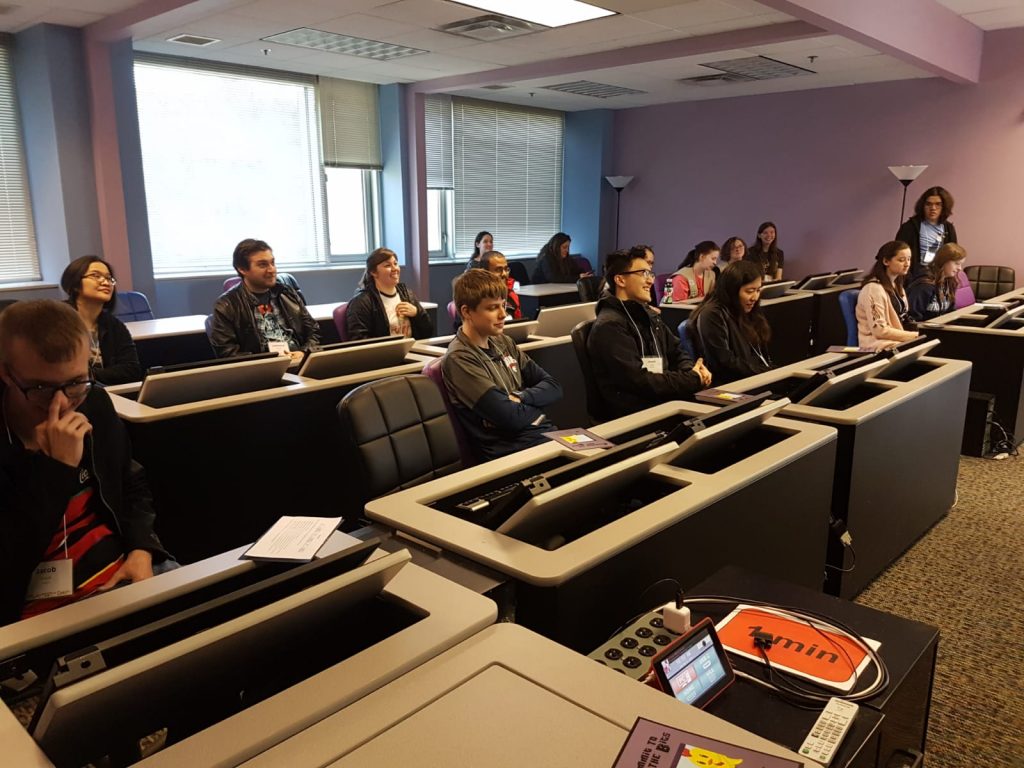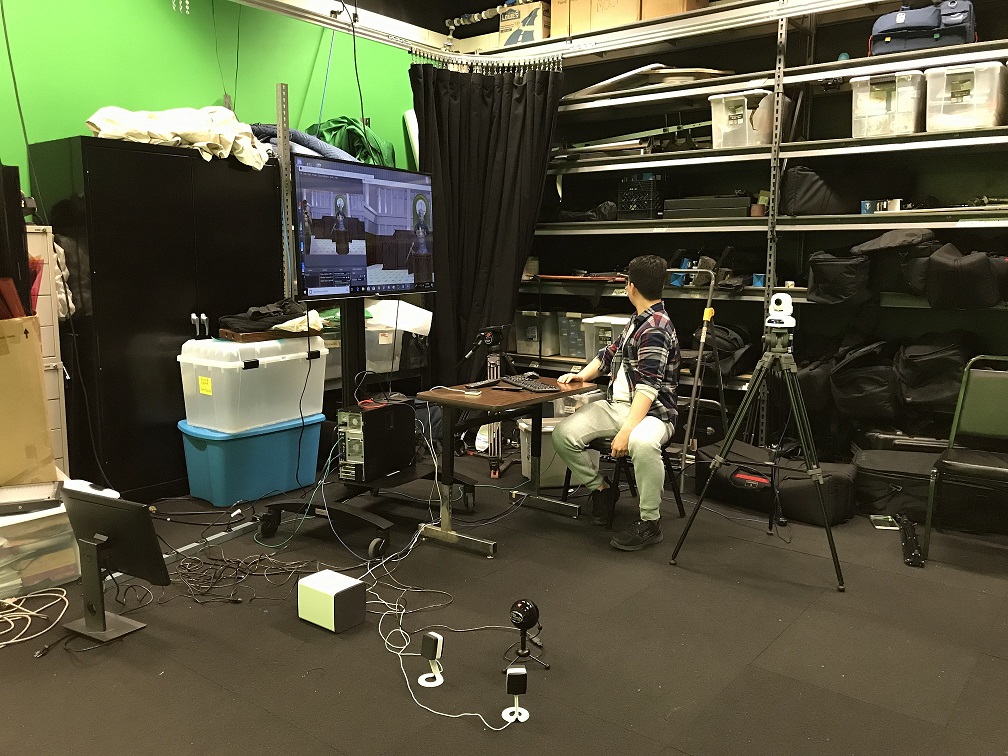Introduction
Commit to the Bits is a discovery project exploring the intersection of improvisational theater and Twitch live streaming. By applying factors unique to Twitch audiences such as their members’ mutual awareness and their potential for dramatic agency, we designed performative frameworks that embrace the character work, active decision-making, and role-playing inherent to improv. Our deliverables are a set of novel user interaction prototypes exploring hypotheses that arise from this design space and documentation of new design principles for it. We primarily worked toward these through methodical playtesting, rapid prototyping, and qualitative and quantitative data analysis over fifteen weeks in Spring 2019.
Foundation
We began by mapping out various parts of each medium. We read roughly 50 research papers on topics relevant to improvisational theater and emerging design ideas on live streaming platforms. Using knowledge gained from this literature review, we drew up diagrams illustrating our understanding of how a live streaming and improv combination may be approached, including this!
We needed to make necessary assumptions of our users to produce prototypes. While we identified pros and cons about audiences of different skill levels, we eventually determined that our audience should be comprised of streamers highly-skilled in improv performing for a Twitch audience with average improv experience and knowledge. This choice was made because we predicted it would both have the largest potential audience with the highest potential for quality entertainment.
To narrow our scope, we focused on three primary qualities:
Interaction Types
Voting
Voting was used in Freeze Tag and to an extent in Music to my Peers. This was the simplest starting point for the project as it already exists in Twitch experiences such as Choice Chamber and Twitch Plays Pokemon. It was easy to aggregate audience inputs literally via polling.
Audience members voted on peer submissions in Freeze Tag while the scenes were running. At the end of a scene, tallied answers were displayed for a time, before the voting session repeated. This segmented voting pattern allowed for a series of rising and lowering tension, but we did not capitalize on this much.
Surprisingly, less viewers voted on content than submitted it. Of active viewers, 67% voted during these two games. This was a good first step into the space, but we potentially spent too much time on it.
Audience Submissions
Audience Submissions are a common interaction in improv acting. Improvisers usually ask for a suggestion, based around a theme or some question, to begin their scenes with. Sometimes they develop dialogues with audience members to draw out more ideas. We wanted to both translate this system directly to understand improv better, and approach it in a way impossible to do on an average stage.
Text Submissions were our direct translation of traditional solicitation of audience suggestions, appearing in Freeze Tag and Guesstination Unknown.
Image Submissions were more novel, appearing in Whose Bag Is It Anyway? Viewers were given a Google Drive link and allowed to upload any image they liked. These were curated behind the scenes so no inappropriate content was shown on stream. We believe this was a high barrier of entry, and was something we could’ve done better.
83% of active users submitted either text or an image throughout any applicable game, making this surprisingly effective. We strived for a feeling of realistic potential to impact the scene, and the majority of these active users felt that. This was our largest success.
Guest Stars
Guest Stars were a maximization of audience involvement. In Discourt, audience members literally joined the scene by calling in via a VoIP program (Discord). This method bypassed Twitch’s audio/video delay by bringing it down to around 0.5 seconds and allowed guest stars the entire range of communication possible verbally.
This made viewers feel a greater responsibility to entertain other viewers. Furthermore, it required an additional account beyond just a Twitch account. Both of these created a large barrier to entry. In our playtest, one of our viewers attempted to call in, but was stumped by the interface of Discord. We ended up having to call in ourselves to keep the show going, a bad judgement call.
Music To My Peers also included a milder element of guest starring. By revealing to the rest of the viewers who the selected DJ for the game was, viewers could communicate with them in chat and influence their decision for which song to pick.
Guessing
Guessing was an interaction made to distance our project from our other interactions as much as possible. Relative novelty was the driving force behind its appearance in Guesstination Unknown, but not much else was acquired from this interaction.
General Interaction Reflections
Much of our general feedback was that audience members wanted more control over what was going on in every game. While the majority (83%) of our audience felt they had a realistic potential to impact or control the scene, they all wanted more breadth to their inputs. It will be challenging to balance the limitations of direct control with the inherent broadcast delay, but we are confident there are interesting and novel ways to design around delay while giving the audience at the very least the illusion of direct control and very best full control.
When brainstorming these interaction types, we often approached them from either the live streaming or the improv side of things. This was close-minded. For the first half of the semester, we had not thought of voting as much more than the easiest way to have audience interactions. While interviewing a professional improviser, we asked him for his most wanted feature: it was voting. Polling an audience may not be innovative on Twitch, but is unique in live theater. From then on, we still tried to consider where any interaction type would be innovating in, but always considering what it could offer to both.
What Could Have Been Better
Securing a consistent and attentive viewership was difficult for a remote experience, especially with regards to collecting feedback. We did this by sending feedback surveys via email, but our responses were inconsistent. Future teams should leverage other resources they have at their disposal to get a constant number of playtesters (e.g. main campus), rather than rely on word of mouth.
Having a more robust knowledge of full-stack web development would have sped up development, since Twitch extensions are essentially web applications. Future teams should have programmers who are more familiar with web development processes and architecture in order for the prototype to be more extensible. We will include a sketch of a better potential architecture in our full documentation to pass on.
Crowd feel was a large trouble point throughout the semester. It is difficult to have contagious laughter when no one is sitting next to you, and it is hard for actors to receive feedback. The largest problem that future teams will have is having a proper and natural dialogue between the audience and performers that creates a collaborative social atmosphere. Our work is only the beginning with this, and needs a lot of work to finish, but we’re confident we have a strong baselines of what interactions need to be supported by a good social underpinning.
For a more in-depth view of our project, please view our full report.



